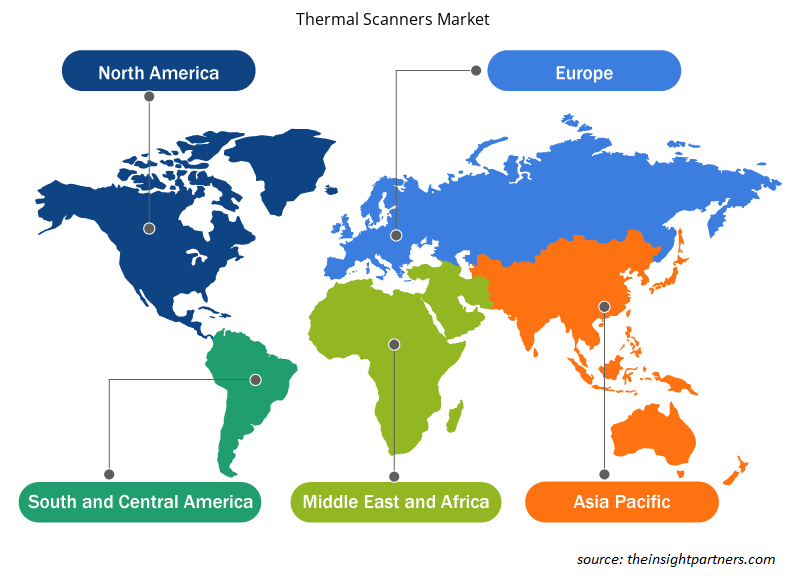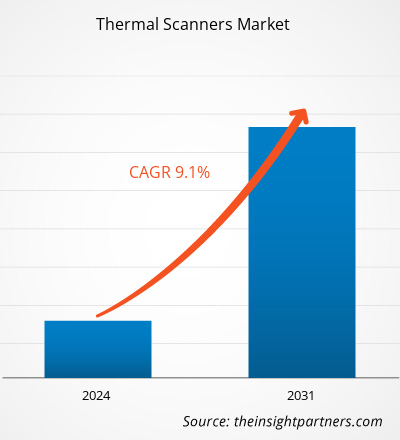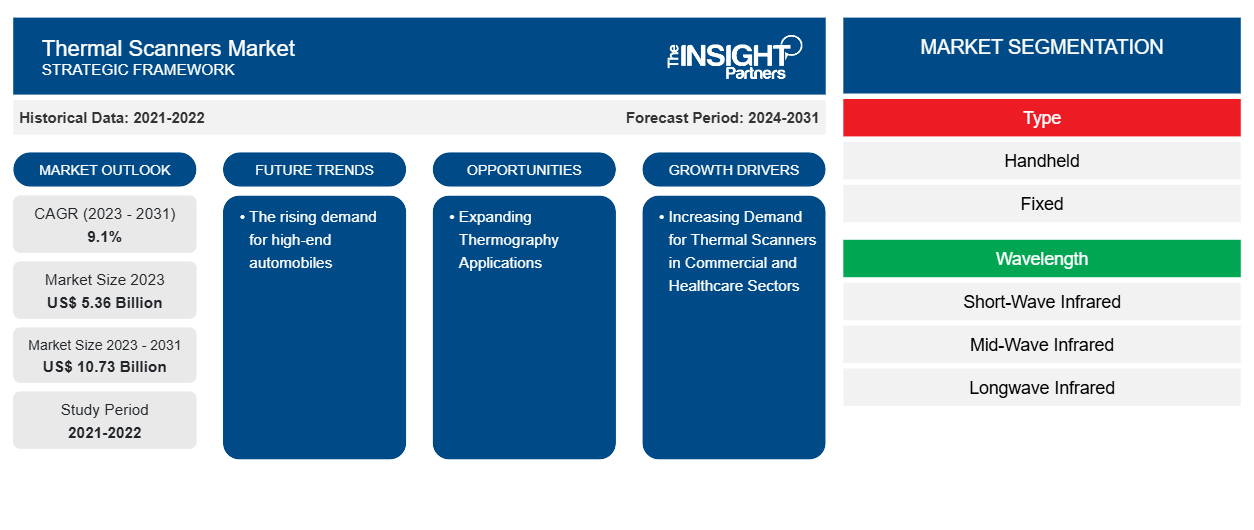热扫描仪市场规模预计将从 2023 年的 53.6 亿美元增至 2031 年的 107.3 亿美元。预计 2023-2031 年市场复合年增长率将达到 9.1%。高端汽车需求的不断增长可能仍是热扫描仪市场的主要趋势。
热扫描仪市场分析
由于商业和医疗保健领域对热扫描仪的需求不断增长,以及对开发创新热扫描仪的研发投资不断增加,热扫描仪市场正在快速增长。由于机场、医院和其他用于检测目的的公共场所的安装量不断增加,市场正在稳步扩大。此外,不断扩大的热成像应用、技术进步以及人工智能和面部识别技术的集成为市场增长提供了丰厚的机会。
热扫描仪市场概况
红外热扫描仪是一种非侵入式成像仪器,可检测任何物体产生的热量并将其转换为电信号。它们的应用范围不断扩大,涉及各种环境,包括工业运营、治疗中心、研究实验室和警察执法等。近年来,许多应用的多样化和增长推动了热扫描仪在多个经济体的销量增长。
定制此报告以满足您的需求
您可以免费定制任何报告,包括本报告的部分内容、国家级分析、Excel 数据包,以及为初创企业和大学提供优惠和折扣
- 获取此报告的关键市场趋势。这个免费样品将包括数据分析,从市场趋势到估计和预测。
热扫描仪市场驱动因素和机遇
商业和医疗保健领域对热扫描仪的需求不断增长,推动市场发展
商业和医疗保健领域对热扫描仪的需求很大,用于安全和监控应用。对安全和监控应用的需求不断增长,以及对员工和居民更高安全性的需求推动了市场的发展。与闭路电视系统相比,热扫描仪成本低廉,可为用户提供高投资回报率 (ROI)。基于热像仪的安全系统的总安装成本远低于闭路电视系统,这增加了其在商业和医疗保健领域的采用。然而,商业和医疗保健领域对基础设施系统的投资增加,加上对专业监控的需求,预计将推动市场的发展。
扩大热成像应用——热扫描仪市场的机会
热成像技术在医疗行业中被广泛用于监测血压、心脏手术、诊断肝病和检测乳腺癌等。热成像应用使用部署在热扫描仪中的红外摄像机来帮助检测身体组织中的血流和热模式。此外,医疗行业支出的增加以及对开发先进热扫描仪的研发活动的增加,在预测期内为市场创造了巨大的增长机会。
热扫描仪市场报告细分分析
有助于得出热扫描仪市场分析的关键部分是类型、波长和最终用途。
- 根据类型,热扫描仪市场分为手持式和固定式。固定式部分在 2023 年占据了更大的市场份额。
- 根据波长,热扫描仪市场分为短波红外、中波红外和长波红外。长波红外部分在 2023 年占据了更大的市场份额。
- 就最终用途而言,市场分为工业、航空航天和国防、汽车、石油和天然气等。航空航天和国防领域在 2023 年占据了更大的市场份额。
热扫描仪市场份额按地区分析
热扫描仪市场报告的地理范围主要分为五个区域:北美、亚太、欧洲、中东和非洲以及南美/南美和中美。就收入而言,由于航空航天和国防工业的扩张,北美占据了热扫描仪市场的最大份额。
亚太地区的市场预计在不久的将来会扩大,这归功于许多供应商提供低成本解决方案,这增加了终端用户对热扫描仪的需求。增加投资和扩大众多行业,包括工业、航空航天和国防、汽车、石油和天然气等,正在为市场创造机会。这些行业大量采用热扫描仪进行监控,从而促进了大规模生产。从而在预测期内推动市场发展。
热扫描仪市场区域洞察
Insight Partners 的分析师已详细解释了预测期内影响热扫描仪市场的区域趋势和因素。本节还讨论了北美、欧洲、亚太地区、中东和非洲以及南美和中美洲的热扫描仪市场细分和地理位置。

- 获取热扫描仪市场的区域特定数据
热扫描仪市场报告范围
| 报告属性 | 细节 |
|---|---|
| 2023 年的市场规模 | 53.6亿美元 |
| 2031 年市场规模 | 107.3亿美元 |
| 全球复合年增长率(2023 - 2031) | 9.1% |
| 史料 | 2021-2022 |
| 预测期 | 2024-2031 |
| 涵盖的领域 | 按类型
|
| 覆盖地区和国家 | 北美
|
| 市场领导者和主要公司简介 |
|
热扫描仪市场参与者密度:了解其对业务动态的影响
热扫描仪市场正在快速增长,这得益于终端用户需求的不断增长,而这些需求又源于消费者偏好的不断变化、技术进步以及对产品优势的认识不断提高等因素。随着需求的增加,企业正在扩大其产品范围,进行创新以满足消费者的需求,并利用新兴趋势,从而进一步推动市场增长。
市场参与者密度是指在特定市场或行业内运营的企业或公司的分布情况。它表明相对于给定市场空间的规模或总市场价值,有多少竞争对手(市场参与者)存在于该市场空间中。
在热扫描仪市场运营的主要公司有:
- FLIR系统公司
- 阿美特克公司
- 罗伯特·博世有限公司
- 3M
- 莱昂纳多
- 光电工业
免责声明:上面列出的公司没有按照任何特定顺序排列。

- 获取热扫描仪市场顶级关键参与者概述
热扫描仪市场新闻和最新发展
热扫描仪市场通过收集一手和二手研究后的定性和定量数据进行评估,其中包括重要的公司出版物、协会数据和数据库。以下是热扫描仪市场的发展和策略列表:
- 2024 年 1 月,Valeo 和 Teledyne FLIR 将为夜视 ADAS 提供首款汽车安全完整性等级 (ASIL) B 热成像技术。该系统将补充 Valeo 的大量传感器,并依靠 Valeo 的 ADAS 软件堆栈来支持乘用车和商用车以及自动驾驶汽车的夜间自动紧急制动 (AEB) 等功能。(来源:Valeo,新闻稿,2024 年)
热扫描仪市场报告覆盖范围和交付成果
“热扫描仪市场规模和预测(2021-2031)”报告对以下领域进行了详细的市场分析:
- 范围内所有主要细分市场的全球、区域和国家层面的市场规模和预测
- 市场动态,如驱动因素、限制因素和关键机遇
- 未来主要趋势
- 详细的 PEST/波特五力分析和 SWOT 分析
- 全球和区域市场分析涵盖关键市场趋势、主要参与者、法规和最新市场发展
- 行业格局和竞争分析,涵盖市场集中度、热点图分析、知名参与者和最新发展
- 详细的公司简介
- 历史分析(2 年)、基准年、预测(7 年)及复合年增长率
- PEST和SWOT分析
- 市场规模、价值/数量 - 全球、区域、国家
- 行业和竞争格局
- Excel 数据集
近期报告
客户评价
购买理由
- 明智的决策
- 了解市场动态
- 竞争分析
- 客户洞察
- 市场预测
- 风险规避
- 战略规划
- 投资论证
- 识别新兴市场
- 优化营销策略
- 提升运营效率
- 顺应监管趋势





















 获取免费样品 - 热扫描仪市场
获取免费样品 - 热扫描仪市场